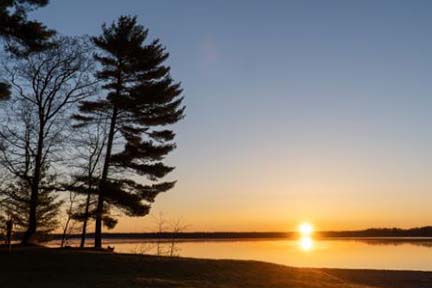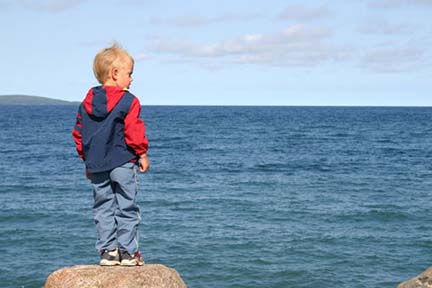| Here are a few of this week’s stories from the Michigan Department of Natural Resources:
See other news releases, Showcasing the DNR stories, photos and other resources at Michigan.gov/DNRPressRoom.
PHOTOS: Larger, higher-res versions of some of the images used in this email – spring peeper, vernal pool, students and ANR – are available in the DNR’s public image gallery. Others (Nature Awaits) are available in this photo folder.
This year marks the golden anniversary of Michigan’s endangered species law, 50 years of protecting the state’s most vulnerable wildlife and rarest plants. Our collective conservation efforts travel the path from brink of extinction to hopeful recovery, working to shape a future where native species can thrive. Here is one of those stories.
 When walking around outdoors this spring – whether in the deep woods or in the wilds of your own backyard, schoolyard or local park – keep an eye out for wicked big puddles. If you see one, look closely and you’ll see that it is teeming with life! Look for the egg masses of frogs and salamanders, tadpoles swimming around, or salamander larvae hiding under leaves. When walking around outdoors this spring – whether in the deep woods or in the wilds of your own backyard, schoolyard or local park – keep an eye out for wicked big puddles. If you see one, look closely and you’ll see that it is teeming with life! Look for the egg masses of frogs and salamanders, tadpoles swimming around, or salamander larvae hiding under leaves.
According to Amy Derosier, supervisor of the DNR Wildlife Division’s Planning and Adaptation Section, if you just bend down and look, you’ll be amazed at what you see. |
Powerhouse puddles
“Vernal pools are small wetlands that often fill up from rain, snow melt or high groundwater in the spring or fall, and they typically dry up by late summer,” Derosier said. “It’s this seasonal flooding and drying cycle that makes vernal pools different from other wetlands and shapes what kinds of critters use them as habitat.”
Because vernal pools dry up, they don’t have fish, which are major predators on young frogs and salamanders. These pools provide a safe haven for a diversity of frogs and salamanders, allowing the young to have greater survival than in other habitats such as ponds. For some frogs and salamanders that return to breed in the very same pools from where they hatched, these individual vernal pools are irreplaceable.
Habitat health benchmarks
 In addition to the diversity of wildlife living under the water – including frogs (like the spring peeper shown here), salamanders, fairy shrimp, beetles and other bugs – vernal pools provide critical watering and feeding places for a plethora of wildlife, including bear, deer, raccoons, skunks, and many other mammals, birds and reptiles. “Sometimes,” Derosier said, “vernal pools are the only water source for miles.” In addition to the diversity of wildlife living under the water – including frogs (like the spring peeper shown here), salamanders, fairy shrimp, beetles and other bugs – vernal pools provide critical watering and feeding places for a plethora of wildlife, including bear, deer, raccoons, skunks, and many other mammals, birds and reptiles. “Sometimes,” Derosier said, “vernal pools are the only water source for miles.”
Rare plants and animals often are dependent on healthy, well-functioning nature to survive. Vernal pools, which help reduce flooding and improve water quality by filtering runoff, can be strong indicators that an area is healthy.
“When we have healthy habitats for rare and unique plants and animals, we have clean water, clean air and places for people to enjoy nature,” Derosier said. “Michigan’s endangered species law is in place to protect the rarest plants and animals. They are part of Michigan’s natural heritage, and they are a part of Michigan’s – and our collective – history, identity and future.” |
How to help
Learn more about vernal pools at the Michigan Vernal Pools Partnership website. You’ll find tons of information about vernal pools and the cool critters that rely on them, as well as ways to get involved in their conservation. To discover more about amphibians and reptiles, check out the Michigan Herp Atlas.
Here are other ways to support conservation:
Questions? Contact Rachel Lincoln, DNR wildlife communications representative, at 517-243-5813.
 Our Nature Awaits program is returning this fall, and teachers can reserve their spots today! Almost a thousand fourth grade teachers from throughout Michigan registered for a free field trip during the 2024-2025 school year, with 100% of participating teachers reporting they would recommend the program to another teacher. Our Nature Awaits program is returning this fall, and teachers can reserve their spots today! Almost a thousand fourth grade teachers from throughout Michigan registered for a free field trip during the 2024-2025 school year, with 100% of participating teachers reporting they would recommend the program to another teacher.
With host locations at state parks including Belle Isle in Detroit, Hoffmaster in Muskegon and the newest state park in Flint, interested fourth grade teachers can find a location near their school. Transportation grants for up to $1,000 are available for public schools, and every participating student receives a free voucher to return with their family to a state park of their choice for more outdoor learning and fun.
“We have worked hard to make all of our students feel safe, supported and psyched for their visits,” said Nature Awaits program coordinator Katie McGlashen. “Fourth graders are at the halfway point of becoming adults with responsibilities. We hope they visit Michigan state parks often throughout their lifetime in any way they choose, whether to fish, camp, bike, bird watch, snowmobile or simply soak up the sunshine.”
To learn more and reserve a field trip, visit Michigan.gov/NatureAwaits. Questions? Email DNR-NatureAwaits@Michigan.gov. |
 On paved pathways and wooded trails, in pairs and in groups, they showed up to run, walk and roll. Some wore wigs or carried paintbrushes and easels, honoring iconic art instructor and television host Bob Ross while supporting tree-planting and forest-protection efforts. On paved pathways and wooded trails, in pairs and in groups, they showed up to run, walk and roll. Some wore wigs or carried paintbrushes and easels, honoring iconic art instructor and television host Bob Ross while supporting tree-planting and forest-protection efforts.
More than 10,000 people, in Michigan and across a dozen other states, participated in this spring’s Run for the Trees: Happy Little (Virtual) 5K. Registrants picked their pace and place – anywhere outdoors – for this DNR virtual event that was held during the week of Earth Day (April 22) and Arbor Day (April 25).
This year, three additional states – Maryland, Virginia and Tennessee – joined the program that began in Michigan in 2019 as a collaboration between the DNR and Bob Ross Inc. Other participating states include Florida, Georgia, Indiana, Ohio, Oregon, Pennsylvania, South Carolina, Washington and Wisconsin.
Participants, who each received a Happy Little T-shirt, sticker, commemorative bib and finisher’s medal, selected their preferred state to support with their registration.
The 2025 event brought in a total of more than $200,000 for tree-planting and forest-protection efforts, with each state receiving a portion based on their participant numbers. Event proceeds included nearly $40,000 in donations; when signing up, registrants could elect to donate beyond the price of their race entry, with these funds also going toward forest-health protection efforts. |
 “I’m incredibly proud of how the Run for the Trees: Happy Little (Virtual) 5K has grown from its roots here in Michigan to now supporting forest health in 13 states across the country,” said Michelle O’Kelly, race director and fund and resource developer for the DNR Parks and Recreation Division. “What started as a creative way to connect people with nature has become a powerful force for conservation, and it’s inspiring to see so many stepping up – virtually and literally – for our forests.” “I’m incredibly proud of how the Run for the Trees: Happy Little (Virtual) 5K has grown from its roots here in Michigan to now supporting forest health in 13 states across the country,” said Michelle O’Kelly, race director and fund and resource developer for the DNR Parks and Recreation Division. “What started as a creative way to connect people with nature has become a powerful force for conservation, and it’s inspiring to see so many stepping up – virtually and literally – for our forests.”
In Michigan, funds raised support the purchase of native trees and shrubs, seed collection and forest canopy protection within state parks. Visitors to state parks where trees have been planted will see bright green “Happy Little Trees Ahead” signs to note the program’s important contributions.
Happy Little 5K is part of the DNR’s tree-planting program, which has produced more than 100,000 native plants, shrubs and trees since its start in 2004. With support from the Bob Ross partnership, more than 2,100 trees have been planted in 20 state parks across Michigan. (Note: The departmentwide impact, which includes growing and planting efforts across the DNR’s parks and recreation, forestry and wildlife divisions, is even bigger: In 2024 alone, the DNR planted more than 6 million trees!)
Registration for the 2026 Run for the Trees: Happy Little (Virtual) 5K will open this fall. Watch the registration site for more details.
Questions? Contact Michelle O’Kelly at 517-899-5211. |
 Did you know that the DNR’s Academy of Natural Resources gives educators from across the state the opportunity to learn about conservation trends from wildlife biologists, foresters, conservation officers and fisheries staff? It’s true – and you can be a part of it all this summer! Did you know that the DNR’s Academy of Natural Resources gives educators from across the state the opportunity to learn about conservation trends from wildlife biologists, foresters, conservation officers and fisheries staff? It’s true – and you can be a part of it all this summer!
Our sessions are designed to empower educators with practical knowledge on a range of vital topics, including effective strategies for incorporating outdoor education into the classroom and tackling subjects like climate change. This year also includes a special session just for prekindergarten through third grade teachers, who can become certified in the early elementary programs for the award-winning Project WILD, Project WET and Project Learning Tree curriculum.
If you are interested, join us July 13-18 for the Academy of Natural Resources Classic at the Ralph A. MacMullan Conference Center, located near Roscommon, or Aug. 3-8 for ANR North in the Upper Peninsula.
With a registration fee of $395 (which includes lodging, meals and course materials) and the opportunity to earn 30 state continuing education clock hours, or SCECH, credits, this is an investment in your professional development you won’t want to miss. See the descriptions for the classes and register today at Michigan.gov/ANR.
Questions? Contact Kevin Frailey, DNR Education Services manager, at 517-231-9046. |
 See more pictures by Michigan state parks photo ambassadors at Instagram.com/MiStateParks. For more on the program, call Stephanie Yancer at 989-274-6182. (This photo is by Karen Allmond, for the Michigan DNR, at Tahquamenon Falls State Park in Paradise, in the eastern Upper Peninsula.) See more pictures by Michigan state parks photo ambassadors at Instagram.com/MiStateParks. For more on the program, call Stephanie Yancer at 989-274-6182. (This photo is by Karen Allmond, for the Michigan DNR, at Tahquamenon Falls State Park in Paradise, in the eastern Upper Peninsula.)
|






 When walking around outdoors this spring – whether in the deep woods or in the wilds of your own backyard, schoolyard or local park – keep an eye out for wicked big puddles. If you see one, look closely and you’ll see that it is teeming with life! Look for the egg masses of frogs and salamanders, tadpoles swimming around, or salamander larvae hiding under leaves.
When walking around outdoors this spring – whether in the deep woods or in the wilds of your own backyard, schoolyard or local park – keep an eye out for wicked big puddles. If you see one, look closely and you’ll see that it is teeming with life! Look for the egg masses of frogs and salamanders, tadpoles swimming around, or salamander larvae hiding under leaves.
 In addition to the diversity of wildlife living under the water – including frogs (like the spring peeper shown here), salamanders, fairy shrimp, beetles and other bugs – vernal pools provide critical watering and feeding places for a plethora of wildlife, including bear, deer, raccoons, skunks, and many other mammals, birds and reptiles. “Sometimes,” Derosier said, “vernal pools are the only water source for miles.”
In addition to the diversity of wildlife living under the water – including frogs (like the spring peeper shown here), salamanders, fairy shrimp, beetles and other bugs – vernal pools provide critical watering and feeding places for a plethora of wildlife, including bear, deer, raccoons, skunks, and many other mammals, birds and reptiles. “Sometimes,” Derosier said, “vernal pools are the only water source for miles.”
 Our Nature Awaits program is returning this fall, and teachers can reserve their spots today! Almost a thousand fourth grade teachers from throughout Michigan registered for a free field trip during the 2024-2025 school year, with 100% of participating teachers reporting they would recommend the program to another teacher.
Our Nature Awaits program is returning this fall, and teachers can reserve their spots today! Almost a thousand fourth grade teachers from throughout Michigan registered for a free field trip during the 2024-2025 school year, with 100% of participating teachers reporting they would recommend the program to another teacher.
 On paved pathways and wooded trails, in pairs and in groups, they showed up to run, walk and roll. Some wore wigs or carried paintbrushes and easels, honoring iconic art instructor and television host Bob Ross while supporting tree-planting and forest-protection efforts.
On paved pathways and wooded trails, in pairs and in groups, they showed up to run, walk and roll. Some wore wigs or carried paintbrushes and easels, honoring iconic art instructor and television host Bob Ross while supporting tree-planting and forest-protection efforts.
 “I’m incredibly proud of how the Run for the Trees: Happy Little (Virtual) 5K has grown from its roots here in Michigan to now supporting forest health in 13 states across the country,” said Michelle O’Kelly, race director and fund and resource developer for the DNR Parks and Recreation Division. “What started as a creative way to connect people with nature has become a powerful force for conservation, and it’s inspiring to see so many stepping up – virtually and literally – for our forests.”
“I’m incredibly proud of how the Run for the Trees: Happy Little (Virtual) 5K has grown from its roots here in Michigan to now supporting forest health in 13 states across the country,” said Michelle O’Kelly, race director and fund and resource developer for the DNR Parks and Recreation Division. “What started as a creative way to connect people with nature has become a powerful force for conservation, and it’s inspiring to see so many stepping up – virtually and literally – for our forests.”
 Did you know that the DNR’s Academy of Natural Resources gives educators from across the state the opportunity to learn about conservation trends from wildlife biologists, foresters, conservation officers and fisheries staff? It’s true – and you can be a part of it all this summer!
Did you know that the DNR’s Academy of Natural Resources gives educators from across the state the opportunity to learn about conservation trends from wildlife biologists, foresters, conservation officers and fisheries staff? It’s true – and you can be a part of it all this summer!
 See more pictures by
See more pictures by 
